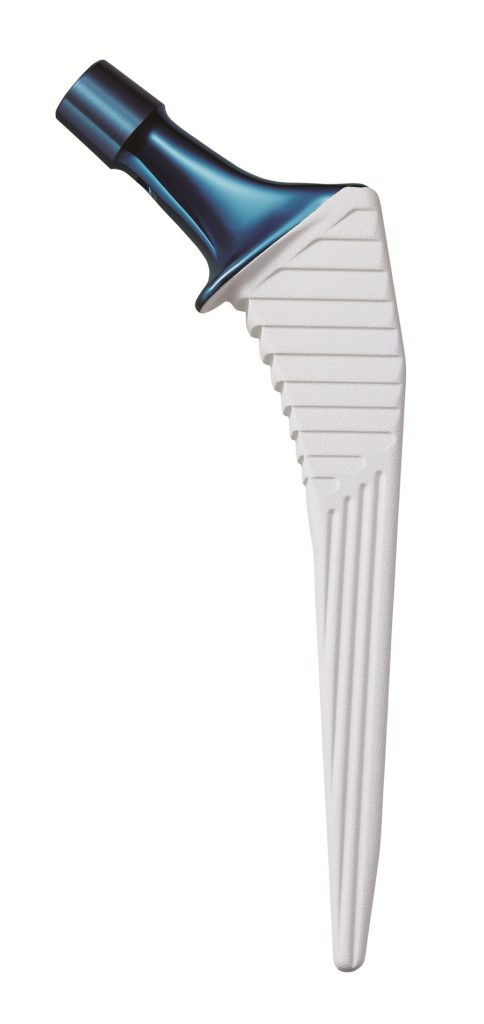Study reveals key insights on the type of femoral stem that minimizes the risk of early postoperative femoral fracture
Total hip replacement (THR) is becoming increasingly common, but postoperative femoral fractures remain a major problem. In a recent study, researchers from Japan compared two widely used femoral stem designs—a key component of hip prostheses—in a large cohort of patients who underwent THR. They found that collared, fully hydroxyapatite-coated stems significantly reduced early femoral fracture risk compared to flat-tapered wedge stems, offering valuable insights for improving patient safety and surgical outcomes in THR.

Image title: A collared, fully hydroxyapatite-coated femoral stem for hip replacement
Image caption: This type of stem was found to be better at preventing early femoral fracture after total hip replacement than flat-tapered wedge stems.
Image credit: Nakashima Health Force Co., Ltd.
Image license: Original content
Usage Restrictions: Any modification, processing, or editing of the images (including changing the aspect ratio or color tone) is prohibited.
As populations continue to age, total hip replacement (THR) is becoming an increasingly common surgical procedure. Experts estimate that approximately one million THRs are performed each year worldwide. The surgery is often life-changing, as it can fully restore the function of the hip joint, reduce pain, and allow patients to walk and bear weight again. However, as with any major surgery, the procedure is not without risks, especially for older individuals with other health conditions.
A significant complication following THR is a femoral fracture—a break in the thigh bone near the artificial hip joint. This is currently the leading cause of reoperation or revision surgery after THR. Nearly half of these fractures occurred early, usually within the first 90 days following surgery. While surgeons have limited control over factors such as their patients’ age, health status, and lifestyle, one critical decision they can influence is the design of the artificial hip implant to use. But which type of hip implant is best at preventing early femoral fractures?
In this view, a research team led by Assistant Professor Rui Hirasawa from the Graduate School of Medicine at Chiba University, Japan, conducted a retrospective study comparing the two most widely used types of femoral stems in THR. Their work, published in Volume 107 of the Bone & Joint Journal on October 1, 2025, was co-authored by Dr. Kazuhiro Oinuma, Executive Director of Funabashi Orthopedic Hospital, and Dr. Yoko Miura, Director of the Joint Reconstruction Centre at Funabashi Orthopedic Hospital, as well as Lecturer Shigeo Hagiwara, Associate Professor Junichi Nakamura, and Professor Seiji Ohtori, from Chiba University.
The two types of femoral stems compared were collared fully hydroxyapatite (HA)-coated stems and flat-tapered wedge stems. The first type features a stabilizing ring or ‘collar’ at the top of the implant that rests on the patient’s bone, and a specialized coating called HA, designed to promote bone growth directly onto the implant for a secure fit. Meanwhile, flat-tapered stems rely purely on their wedge shape and tight fit within the bone canal of the femur to achieve initial stability; they do not have a stabilizing collar or HA coating. “Based on both our clinical impressions and reports in the literature indicating a lower incidence of post-THR femoral fractures with collared fully HA-coated stems, we were inspired to investigate whether these stems could indeed reduce the risk of these fractures,” explains Dr. Hirasawa.
The researchers gathered data from 4,511 THR procedures conducted by a single surgeon in a single medical center from 2009 to 2023. Here, the team used an advanced statistical technique called propensity score matching to produce two highly comparable groups of patients for better analysis. They ultimately matched 1,804 cases where collared HA-coated stems were used with 1,804 cases where flat-tapered wedge stems were used, based on factors such as age, sex, body mass index, and conditions like osteoarthritis. This approach helped minimize the impact of confounding variables.
The results revealed that early post-THR femoral fracture was significantly less frequent among patients with collared HA-coated femoral stems—only two cases of fracture were recorded in this group versus 13 in those with flat-tapered wedge stems. Hence, the researchers investigated each fracture in detail based on available clinical data.
Notably, while the use of collared HA-coated femoral stems was associated with fewer early postoperative femoral fractures, the study also found that the incidence of intraoperative femoral fractures was higher in this group compared to flat-tapered wedge stems. This highlights the importance of further research to optimize surgical techniques and patient selection when using collared HA-coated stems, in order to minimize intraoperative complications.
Overall, the findings of this study suggest that collared HA-coated stems may have inherent advantages over flat-tapered wedge stems, which surgeons should take into account when deciding which type of prosthetic hip to use or recommend. “Our results have the potential to directly improve patient safety and surgical outcomes in THR by helping surgeons make more informed implant selections, leading to fewer serious complications, faster functional recovery, and reduced need for reoperation,” remarks Dr. Hirasawa. “In the long term, this research may set a new global standard for femoral stem selection in hip replacement.”
To see more news from Chiba University, click here.
About Assistant Professor Rui Hirasawa from Chiba University
Dr. Rui Hirasawa is an Assistant Professor at the Department of Orthopedic Surgery of the Graduate School of Medicine, Chiba University, Japan. His research focuses on conditions such as hip and knee osteoarthritis, osteonecrosis of the femoral head, and rheumatoid arthritis. Specifically, he aims to elucidate the role of the immune system in osteoarthritis and translate this knowledge into better treatments. He is a member of several professional societies, including the Japanese Society of Immunology, the Japanese Society of Artificial Joints, and the Japanese Society of Orthopedic Surgery, among others.
Reference:
Title of original paper: Collared fully hydroxyapatite-coated femoral components reduce early periprosthetic femoral fractures in total hip arthroplasty with the direct anterior approach
Authors: Rui Hirasawa1,2, Kazuhiro Oinuma2, Shigeo Hagiwara1, Takamitsu Sato1, Yuya Kawarai1, Yoko Miura2, Junichi Nakamura1, and Seiji Ohtori1
Affiliations: 1Department of Orthopedic Surgery, Graduate School of Medicine, Chiba University
2Funabashi Orthopedic Hospital, Joint Reconstruction Centre
Journal: Bone & Joint Journal
DOI: 10.1302/0301-620X.107B10.BJJ-2024-1494.R1
Contacts:
Rui Hirasawa
Graduate School of Medicine, Chiba University, Japan
Email: r.hirasawa1221@me.com
Kenji Sato
Public Relations Section, Funabashi Orthopedic Hospital
Address: 1-833 Hasamacho, Funabashi, Chiba 274-0822 Japan
Email: kouhou@fff.or.jp
Academic Research & Innovation Management Organization (IMO), Chiba University
Address: 1-33 Yayoi, Inage, Chiba 263-8522 Japan
Email: cn-info@chiba-u.jp



-200x150.jpg)

